
Mannerism is a style in European art that emerged in the later years of the Italian High Renaissance around 1520, spreading by about 1530 and lasting until about the end of the 16th century in Italy, when the Baroque style largely replaced it. Northern Mannerism continued into the early 17th century.

Antonio Allegri da Correggio, usually known as just Correggio was an Italian Renaissance painter who was the foremost painter of the Parma school of the High Italian Renaissance, who was responsible for some of the most vigorous and sensuous works of the sixteenth century. In his use of dynamic composition, illusionistic perspective and dramatic foreshortening, Correggio prefigured the Baroque art of the seventeenth century and the Rococo art of the eighteenth century. He is considered a master of chiaroscuro.
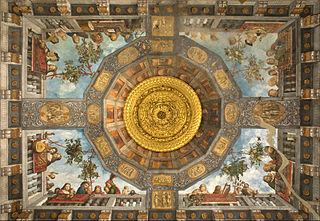
Trompe-l'œil is an artistic term for the highly realistic optical illusion of three-dimensional space and objects on a two-dimensional surface. Trompe l'œil, which is most often associated with painting, tricks the viewer into perceiving painted objects or spaces as real. Forced perspective is a related illusion in architecture.

Giovanni di Niccolò de Luteri, better known as Dosso Dossi, was an Italian Renaissance painter who belonged to the School of Ferrara, painting in a style mainly influenced by Venetian painting, in particular Giorgione and early Titian.

The J. Paul Getty Museum, commonly referred to as the Getty, is an art museum in Los Angeles, California housed on two campuses: the Getty Center and Getty Villa. It is operated by the J. Paul Getty Trust, the world's wealthiest art institution.

The Veil of Veronica, or Sudarium, also known as the Vernicle and often called simply the Veronica, is a Christian relic consisting of a piece of cloth said to bear an image of the Holy Face of Jesus produced by other than human means. Various existing images have been claimed to be the original relic, as well as early copies of it; representations of it are also known as vernicles.
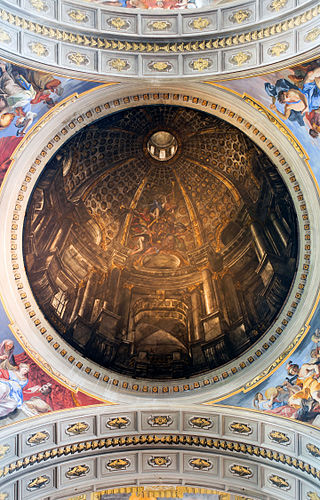
Illusionistic ceiling painting, which includes the techniques of perspective di sotto in sù and quadratura, is the tradition in Renaissance, Baroque and Rococo art in which trompe-l'œil, perspective tools such as foreshortening, and other spatial effects are used to create the illusion of three-dimensional space on an otherwise two-dimensional or mostly flat ceiling surface above the viewer. It is frequently used to create the illusion of an open sky, such as with the oculus in Andrea Mantegna's Camera degli Sposi, or the illusion of an architectural space such as the cupola, one of Andrea Pozzo's frescoes in Sant'Ignazio, Rome. Illusionistic ceiling painting belongs to the general class of illusionism in art, designed to create accurate representations of reality.

The Madonna of the Book, or the Madonna del Libro, is a small painting by the Italian Renaissance artist Sandro Botticelli, and is preserved in the Poldi Pezzoli Museum in Milan. The painting is executed in tempera on panel. It dates from between 1480 and 1481.

The Assumption of the Virgin Mary does not appear in the New Testament, but appears in apocryphal literature of the 3rd and 4th centuries, and by 1000 was widely believed in the Western Church, though not made formal Catholic dogma until 1950. It first became a popular subject in Western Christian art in the 12th century, along with other narrative scenes from the Life of the Virgin, and the Coronation of the Virgin. These "Marian" subjects were especially promoted by the Cistercian Order and Saint Bernard of Clairvaux.

Saint Michael Vanquishing Satan is a painting by the Italian High Renaissance artist Raphael. It shows the archangel Michael standing on top of Satan's back with his right foot. The painting was commissioned by Pope Leo X and has been located in the Louvre in Paris since 1667.

Christ Carrying the Cross is a painting attributed to a follower of Hieronymus Bosch. It was painted in the early 16th century, presumably between 1510 and 1535. The work is housed in the Museum of Fine Arts in Ghent, Belgium. The painting is notable for its use of caricature to provide grotesque-looking faces surrounding Jesus.

Christ Carrying the Cross on his way to his crucifixion is an episode included in the Gospel of John, and a very common subject in art, especially in the fourteen Stations of the Cross, sets of which are now found in almost all Roman Catholic churches, as well as in many Lutheran churches and Anglican churches. However, the subject occurs in many other contexts, including single works and cycles of the Life of Christ or the Passion of Christ. Alternative names include the Procession to Calvary, Road to Calvary and Way to Calvary, Calvary or Golgotha being the site of the crucifixion outside Jerusalem. The actual route taken is defined by tradition as the Via Dolorosa in Jerusalem, although the specific path of this route has varied over the centuries and continues to be the subject of debate.
John Kinder Gowran Shearman was an English art historian who also taught in America. He was a specialist in Italian Renaissance painting, described by his colleague James S. Ackerman as "the leading scholar of Italian Renaissance painting", who published several influential works, but whose expected major book on Quattrocento painting, for the Penguin/Yale History of Art series, never appeared. However, what is widely acknowledged as his most influential book, on the concept of Mannerism, published in 1967, is still in print.
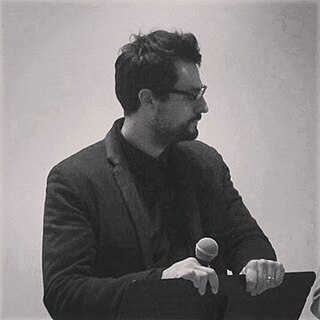
Gabriele Tinti is an Italian poet and writer.

The Bolognini Madonna is an oil-on-panel painting executed ca. 1514–1519 by the Italian Renaissance painter Antonio da Correggio.

Pietà is a c. 1600 oil on canvas painting by Annibale Carracci, the earliest surviving work by him on the subject, which was commissioned by Odoardo Farnese. It moved from Rome to Parma to Naples as part of the Farnese collection and is now in the National Museum of Capodimonte in Naples. It is one of many 16th century Bolognese paintings dedicated to the theme of the Pietà, and it is counted among Carracci's masterpieces.
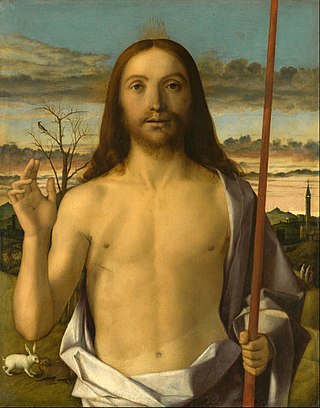
Christ Blessing is a painting by Italian Renaissance master Giovanni Bellini created around the year 1500.
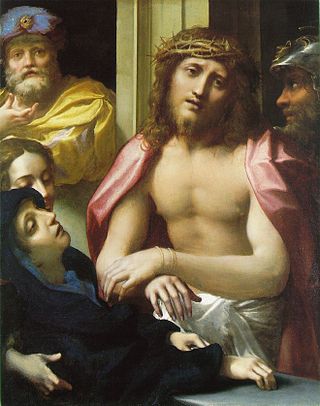
Ecce Homo, also known as Christ Presented to the People, is an oil painting by Antonio da Correggio. It is the last of the surviving pictures of the Passion of Jesus that Correggio executed during the 1520s. The painting is in the National Gallery, London.

The Flight into Egypt is an oil painting usually attributed to the Venetian Renaissance master Titian. This very early work by Titian was made in about 1508 or 1509. The painting is in the collection of the Hermitage Museum in Saint Petersburg, Russia. A religious landscape painting, its "bold brushwork and exhilarating use of color" have led to it being described as one of Titian's masterpieces, as well as one of his earliest. Though some scholars dispute the attribution of the painting to Titian, it is usually accepted as one of his works from the beginning of his career.


















